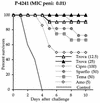Efficacy of trovafloxacin against penicillin-susceptible and multiresistant strains of Streptococcus pneumoniae in a mouse pneumonia model
- PMID: 9559797
- PMCID: PMC105556
- DOI: 10.1128/AAC.42.4.862
Efficacy of trovafloxacin against penicillin-susceptible and multiresistant strains of Streptococcus pneumoniae in a mouse pneumonia model
Abstract
The increasing emergence of penicillin-resistant and multidrug-resistant strains of Streptococcus pneumoniae will create a serious therapeutic problem in coming years. Trovafloxacin is a novel naphthyridone quinolone with promising activity against S. pneumoniae, including penicillin-resistant strains (MIC for 90% of the isolates tested, 0.25 microg/ml). We compared its in vivo efficacy with that of other fluoroquinolones (ciprofloxacin, temafloxacin, and sparfloxacin) and a reference beta-lactam (amoxicillin) in a model of acute experimental pneumonia. Immunocompetent Swiss mice were infected by peroral tracheal delivery of a virulent, penicillin-susceptible strain (MIC, 0.03 microg/ml); leukopenic Swiss mice were infected with three poorly virulent, penicillin-resistant strains (MICs, 4 to 8 microg/ml) and a ciprofloxacin-resistant strain (MIC, 32 microg/ml). Treatments were started 6 h (immunocompetent mice) or 3 h (leukopenic mice) after infection. Doses ranging from 12.5 to 300 mg/kg were given at 12- or 8-h intervals for 3 days. Trovafloxacin (25 mg/kg) was the most effective agent in vivo against penicillin-susceptible and -resistant strains. Corresponding survival rates were 2- to 4-fold higher than with 50-mg/kg sparfloxacin or temafloxacin and 8- to 16-fold higher than with 100-mg/kg ciprofloxacin. The ratios of the area under the concentration-time curve to the MIC in serum and lung tissue were more favorable with trovafloxacin than with the other quinolones. Efficacy in vivo correlated with pharmacokinetic parameters. Trovafloxacin shows potential for the treatment of infections due to penicillin-susceptible and -resistant S. pneumoniae but appears to be ineffective against a ciprofloxacin-resistant strain.
Figures



Similar articles
-
Activities of trovafloxacin, gatifloxacin, clinafloxacin, sparfloxacin, levofloxacin, and ciprofloxacin against penicillin-resistant Streptococcus pneumoniae in an in vitro infection model.Antimicrob Agents Chemother. 2000 Mar;44(3):598-601. doi: 10.1128/AAC.44.3.598-601.2000. Antimicrob Agents Chemother. 2000. PMID: 10681324 Free PMC article.
-
In vivo efficacy of a new fluoroquinolone, sparfloxacin, against penicillin-susceptible and -resistant and multiresistant strains of Streptococcus pneumoniae in a mouse model of pneumonia.Antimicrob Agents Chemother. 1992 Dec;36(12):2698-703. doi: 10.1128/AAC.36.12.2698. Antimicrob Agents Chemother. 1992. PMID: 1336343 Free PMC article.
-
Antipneumococcal activities of gemifloxacin compared to those of nine other agents.Antimicrob Agents Chemother. 2000 Feb;44(2):304-10. doi: 10.1128/AAC.44.2.304-310.2000. Antimicrob Agents Chemother. 2000. PMID: 10639354 Free PMC article.
-
Pharmacodynamics to combat resistance.J Antimicrob Chemother. 2000 Jul;46 Suppl T1:25-31. doi: 10.1093/oxfordjournals.jac.a020890. J Antimicrob Chemother. 2000. PMID: 10997596 Review.
-
Bacteriological activity of trovafloxacin, a new quinolone, against respiratory tract pathogens.Eur J Clin Microbiol Infect Dis. 1998 Jun;17(6):405-12. doi: 10.1007/BF01691573. Eur J Clin Microbiol Infect Dis. 1998. PMID: 9758283 Review.
Cited by
-
Activities of trovafloxacin, gatifloxacin, clinafloxacin, sparfloxacin, levofloxacin, and ciprofloxacin against penicillin-resistant Streptococcus pneumoniae in an in vitro infection model.Antimicrob Agents Chemother. 2000 Mar;44(3):598-601. doi: 10.1128/AAC.44.3.598-601.2000. Antimicrob Agents Chemother. 2000. PMID: 10681324 Free PMC article.
-
Novel murine model of pneumococcal pneumonia: use of temperature as a measure of disease severity to compare the efficacies of moxifloxacin and levofloxacin.Antimicrob Agents Chemother. 2004 Sep;48(9):3343-8. doi: 10.1128/AAC.48.9.3343-3348.2004. Antimicrob Agents Chemother. 2004. PMID: 15328095 Free PMC article.
-
Development of a new experimental model of penicillin-resistant Streptococcus pneumoniae pneumonia and amoxicillin treatment by reproducing human pharmacokinetics.Antimicrob Agents Chemother. 1999 Oct;43(10):2484-92. doi: 10.1128/AAC.43.10.2484. Antimicrob Agents Chemother. 1999. PMID: 10508029 Free PMC article.
-
A strain-independent method to induce progressive and lethal pneumococcal pneumonia in neutropenic mice.J Biomed Sci. 2015 Mar 25;22(1):24. doi: 10.1186/s12929-015-0124-4. J Biomed Sci. 2015. PMID: 25890037 Free PMC article.
-
Pharmacodynamics of levofloxacin and ciprofloxacin in a murine pneumonia model: peak concentration/MIC versus area under the curve/MIC ratios.Antimicrob Agents Chemother. 2003 Sep;47(9):2749-55. doi: 10.1128/AAC.47.9.2749-2755.2003. Antimicrob Agents Chemother. 2003. PMID: 12936969 Free PMC article.
References
-
- Appelbaum P C. Antimicrobial resistance in Streptococcus pneumoniae: an overview. Clin Infect Dis. 1992;15:77–83. - PubMed
-
- Appelbaum, P. C. 1996. Emergence of resistance to antimicrobial agents in gram-positive bacteria—pneumococci. Drugs 51(Suppl. 1):1–5. - PubMed
-
- Aubier, M., H. Lode, G. Gialdroni-Grassi, G. Huchon, J. Hosie, N. Legakis, C. Regamey, S. Segev, R. Vester, W. J. Wijnands, and N. Tolstuchow. 1996. Sparfloxacin for the treatment of community acquired pneumonia: a pooled data analysis of two studies. J. Antimicrob. Chemother. 37(Suppl. A):73–82. - PubMed
-
- Azoulay-Dupuis E, Bédos J P, Vallée E, Hardy D J, Swanson R N, Pocidalo J J. Antipneumococcal activity of ciprofloxacin, ofloxacin, and temafloxacin in an experimental mouse pneumonia model at various stages of the disease. J Infect Dis. 1991;163:319–324. - PubMed
-
- Azoulay-Dupuis E, Vallée E, Veber B, Bédos J P, Bauchet J, Pocidalo J J. In vivo efficacy of a new fluoroquinolone, sparfloxacin, against penicillin-susceptible and -resistant and multiresistant strains of Streptococcus pneumoniae in a mouse model of pneumonia. Antimicrob Agents Chemother. 1992;36:2698–2703. - PMC - PubMed
MeSH terms
Substances
LinkOut - more resources
Full Text Sources
Other Literature Sources
Medical

